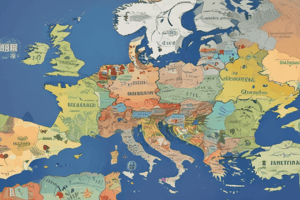Podcast
Questions and Answers
Which initiative was most instrumental in transitioning the European vision from preventing war to fostering economic interdependence?
Which initiative was most instrumental in transitioning the European vision from preventing war to fostering economic interdependence?
- The implementation of the Schengen Agreement promoting border-free travel.
- The formation of the European Court of Justice to enforce international law.
- The establishment of the European Council to mediate international disputes.
- The creation of the European Coal and Steel Community (ECSC). (correct)
What is the function of the EU single market?
What is the function of the EU single market?
- To create a common agricultural policy ensuring food self-sufficiency within the Union.
- To standardize fiscal policies across all member states to prevent economic disparities.
- To establish a uniform defense strategy and military alliance.
- To permit unrestricted movement of goods, services, people, and capital among member nations. (correct)
If a non-member country seeks to improve its human rights record to align with international standards, what type of support can it expect from the EU?
If a non-member country seeks to improve its human rights record to align with international standards, what type of support can it expect from the EU?
- Mandatory political asylum for all citizens seeking refuge from persecution.
- Financial aid and technical assistance to strengthen civil society organizations. (correct)
- Imposition of strict economic sanctions until reforms are implemented.
- Direct military intervention to enforce human rights.
How does the EU's commitment to human rights influence its approach to international trade agreements?
How does the EU's commitment to human rights influence its approach to international trade agreements?
The EU provides approximately what percentage of global Overseas Development Assistance?
The EU provides approximately what percentage of global Overseas Development Assistance?
What strategic advantage does the EU gain by operating as a unified bloc in international relations?
What strategic advantage does the EU gain by operating as a unified bloc in international relations?
Which treaty played a crucial role in transitioning the European project from a primarily economic focus to one encompassing broader political and social dimensions?
Which treaty played a crucial role in transitioning the European project from a primarily economic focus to one encompassing broader political and social dimensions?
How does the EU address global challenges such as climate change and cybersecurity?
How does the EU address global challenges such as climate change and cybersecurity?
Flashcards
What is the EU?
What is the EU?
A supranational political and economic union of 27 European member states.
Why was the EU created?
Why was the EU created?
To promote peace, stability, and economic cooperation among European nations after World War II.
What was the ECSC?
What was the ECSC?
Ensuring war-related industries (coal and steel) were jointly managed to prevent future conflicts.
What was the EEC?
What was the EEC?
Signup and view all the flashcards
What is the EU's single market?
What is the EU's single market?
Signup and view all the flashcards
EU's political aim
EU's political aim
Signup and view all the flashcards
EU's global presence
EU's global presence
Signup and view all the flashcards
EU commitment to human rights
EU commitment to human rights
Signup and view all the flashcards
Study Notes
- The EU is a supranational political and economic union of 27 member states.
- The EU has an estimated population of 450 million people.
- The European Union (EU) was created to promote peace, stability, and economic cooperation among European nations.
Preventing Future Wars
- After World War II, European countries wanted to avoid another devastating conflict.
- Stronger economic and political ties would make war less likely.
Economic Cooperation and Growth
- The EU started as the European Coal and Steel Community (ECSC) in 1951.
- The ECSC ensured that war-related industries were jointly managed.
- In 1957, the Treaty of Rome created the European Economic Community (EEC).
- The EEC formed a common market to boost trade and prosperity.
- The EU created a single market allowing free movement of goods, services, people, and capital.
- It removed trade barriers and helped member economies grow together.
Political Unity and Stability
- The EU aimed to bring European countries together under shared democratic values.
- It promotes human rights, the rule of law, and good governance across member states.
Stronger Global Presence
- By acting as a unified bloc, the EU gives Europe a stronger voice in international politics and trade.
- It helps negotiate global agreements on climate, security, and trade policies.
Addressing Global Challenges
- The EU works together on issues like climate change, cybersecurity, human rights, and migration.
- Collective action makes it more effective than individual countries acting alone.
Importance for Human Rights Advocacy
- The EU is an essential target for human rights advocacy worldwide.
Economic and Political Leverage
- The EU is a major global economic force, accounting for around 14% of the world’s trade in goods.
- The EU and its member states provide approximately 60% of global Overseas Development Assistance.
Commitment to Human Rights
- The EU is committed to promoting international human rights standards worldwide.
- Article 3 of the Treaty of the European Union outlines the EU's external objectives.
- These include poverty eradication, human rights protection, and adherence to international law.
Support for Civil Society
- The EU is the world’s largest donor supporting human rights NGOs.
- Between 2021 and 2027, €1.511 billion was allocated globally for democracy and human rights promotion.
- This was primarily channeled through civil society actors.
- Programs like ProtectDefenders.eu offer direct support to human rights defenders, even in closed spaces.
- The EU-Egypt Strategic Partnership, signed in 2024, committed €7.4 billion in loans and grants to Egypt.
- Egypt is the EU’s largest trading partner in the region.
- Egypt contributes 0.7% of EU imports, while the EU accounts for 24.8% of Egypt’s trade.
- The EU often has greater leverage in partner countries due to its political and economic ties.
Studying That Suits You
Use AI to generate personalized quizzes and flashcards to suit your learning preferences.




